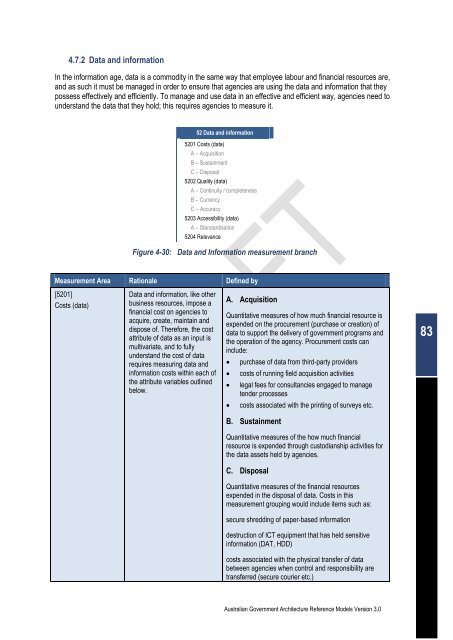Australian Government Architecture Reference Models Version 3.0
Australian Government Architecture Reference Models Version 3.0
Australian Government Architecture Reference Models Version 3.0
Create successful ePaper yourself
Turn your PDF publications into a flip-book with our unique Google optimized e-Paper software.
4.7.2 Data and information<br />
In the information age, data is a commodity in the same way that employee labour and financial resources are,<br />
and as such it must be managed in order to ensure that agencies are using the data and information that they<br />
possess effectively and efficiently. To manage and use data in an effective and efficient way, agencies need to<br />
understand the data that they hold; this requires agencies to measure it.<br />
52 Data and information<br />
5201 Costs (data)<br />
A – Acquisition<br />
B – Sustainment<br />
C – Disposal<br />
5202 Quality (data)<br />
A – Continuity / completeness<br />
B – Currency<br />
C – Accuracy<br />
5203 Accessibility (data)<br />
A – Standardisation<br />
5204 Relevance<br />
Figure 4-30: Data and Information measurement branch<br />
Measurement Area Rationale Defined by<br />
[5201]<br />
Costs (data)<br />
Data and information, like other<br />
business resources, impose a<br />
financial cost on agencies to<br />
acquire, create, maintain and<br />
dispose of. Therefore, the cost<br />
attribute of data as an input is<br />
multivariate, and to fully<br />
understand the cost of data<br />
requires measuring data and<br />
information costs within each of<br />
the attribute variables outlined<br />
below.<br />
A. Acquisition<br />
Quantitative measures of how much financial resource is<br />
expended on the procurement (purchase or creation) of<br />
data to support the delivery of government programs and<br />
the operation of the agency. Procurement costs can<br />
include:<br />
� purchase of data from third-party providers<br />
� costs of running field acquisition activities<br />
� legal fees for consultancies engaged to manage<br />
tender processes<br />
� costs associated with the printing of surveys etc.<br />
B. Sustainment<br />
Quantitative measures of the how much financial<br />
resource is expended through custodianship activities for<br />
the data assets held by agencies.<br />
C. Disposal<br />
Quantitative measures of the financial resources<br />
expended in the disposal of data. Costs in this<br />
measurement grouping would include items such as:<br />
secure shredding of paper-based information<br />
destruction of ICT equipment that has held sensitive<br />
information (DAT, HDD)<br />
costs associated with the physical transfer of data<br />
between agencies when control and responsibility are<br />
transferred (secure courier etc.)<br />
<strong>Australian</strong> <strong>Government</strong> <strong>Architecture</strong> <strong>Reference</strong> <strong>Models</strong> <strong>Version</strong> <strong>3.0</strong><br />
83

















